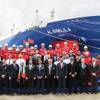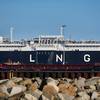Great Lakes Maritime Task Force Report
Thanks to a significant increase in funding for dredging on the Great Lakes in FY08, the U.S. Army Corps of Engineers was finally able to start reducing the backlog of sediment that is clogging the Great Lakes Navigation System announced Great Lakes Maritime Task Force in its 2008 Annual Report released March 20.
“Congress really stepped up to the plate and gave the Corps nearly $140m to dredge Great Lakes ports and waterways in FY08. As a result, for the first time in many years, the Corps could both remove all the sediment that builds up in the course of a year and actually start to chip away at the 18 million cubic yards that remain.”
The outlook for FY09 initially was not as positive. The Bush Administration’s final budget proposed to slash the Lakes’ dredging appropriation by nearly $50m. “Thanks to the Great Lakes delegation, the omnibus bill did bring the Lakes’ dredging appropriation back up to $125m, an increase of $35m over what the Bush Administration had proposed. The economic stimulus package may also include some additional funds for Lakes dredging.”
The Task Force stressed the need to jump start the economy makes the dredging crisis even more of a millstone around the nation’s neck. “The economic stimulus bill wisely chose to use American-made goods and materials to the degree possible, but most of the steel made in our country begins as iron ore and fluxstone that moves on the Great Lakes. Every ton of iron ore that stays on the loading dock means less steel and fewer new jobs. Every ton of aggregate or cement that is left lessens our ability to promote and sustain economic growth.”
The dredging crisis can be solved if the Harbor Maintenance Trust Fund (HMTF) is used for its intended purpose – dredging deep-draft ports and waterways. The fund has a surplus of nearly $5b. “The Harbor Maintenance Trust Fund (that’s where the Port Use Tax revenues go) takes in about $1.1b a year, yet withdrawals are only about $700m a year. The excess – now nearly $5b – is used to paper balance the budget. Jim Weakley, our 2nd Vice President in 2008 and President of Lake Carriers’ Association, testified in Washington about the need to use the Harbor Maintenance Trust Fund for its intended purpose. Fortunately, more and more members of Congress are getting the message: We can maintain our nation’s deep-draft ports and waterways if we spend what the taxpayer puts into the HMTF each year.”
The dredging crisis was the focus of GLMTF’s 13th Annual Informational Briefing for the Great Lakes Delegation in Washington on April 2, 2008. The keynote address was given by Daniel J. Cornillie, Manager – Marine and Raw Materials Logistics for ArcelorMittal U.S.A. – Indiana Harbor. ArcelorMittal is America’s largest steelmaker, with about 21,000 employees who make about 25 percent of the nation’s steel.
“More than half of ArcelorMittal U.S.A.’s jobs are in facilities immediately adjacent to the Great Lakes,” said Cornillie. “This is not a coincidence. The Great Lakes link the iron ore and stone from the north with the coal to the south. We require approximately 26 million tons per year of Lake-delivered raw materials to sustain ArcelorMittal’s production and jobs in just its U.S. Lakes mills. That is approximately 3,000 tons of material per hour, 24/7.”
The dredging crisis is directly affecting ships delivering raw materials to ArcelorMittal’s complex in Indiana Harbor. “Twenty years ago, our time-chartered M/V JOSEPH L. BLOCK, for example, was carrying summertime loads of approximately 41,000 tons. Last summer, on the same runs, she carried less than 35,000 tons. She has to make six trips to deliver what she did in five. This math is being repeated across the U.S.-Flag Lakes fleet.”
Cornillie pointed out that the cost to restore the Great Lakes Navigation System to project dimensions (more than $200m) would be less than half that recently spent on reconfiguring one freeway intersection south of Chicago.
GLMTF has already begun working on its recommendations for the FY10 dredging budget. “We cannot address every need in one year or one budget, but we must not let what we accomplished in FY08 become just a highlight. It must become that standard against which we are now measured.”
Founded in 1992, Great Lakes Maritime Task Force promotes domestic and international shipping on the Great Lakes. It is the largest coalition to ever speak for the Great Lakes shipping community and draws its membership from both labor and management representing U.S.-Flag vessel operators, shipboard and longshore unions, port authorities, cargo shippers, terminal operators, shipyards and other Great Lakes interests. Its goals include restoring adequate funding for dredging of Great Lakes deep-draft ports and waterways, construction of a second Poe-sized lock at Sault Ste. Marie, Michigan; protecting the Jones Act and other U.S. maritime cabotage laws and regulations; maximizing the Lakes overseas trade; and opposing exports and increased diversions of Great Lakes water.












